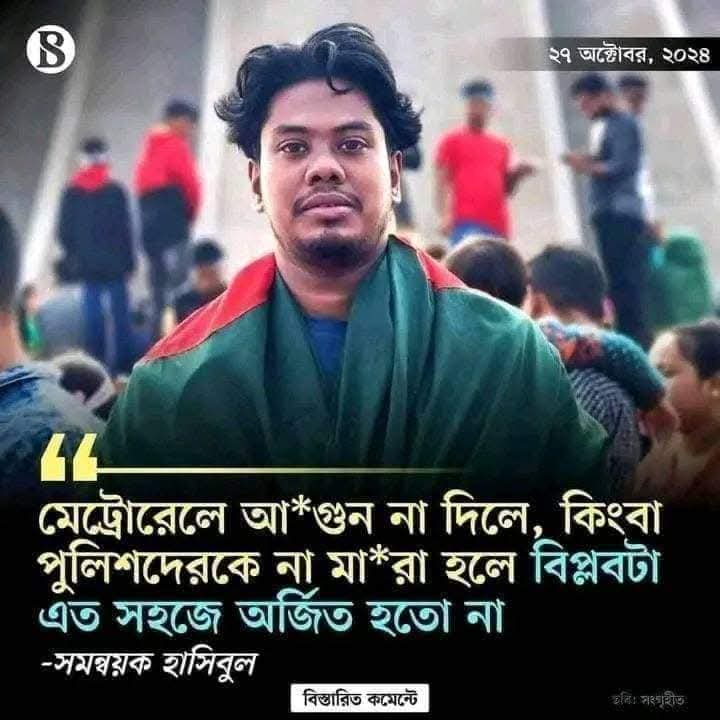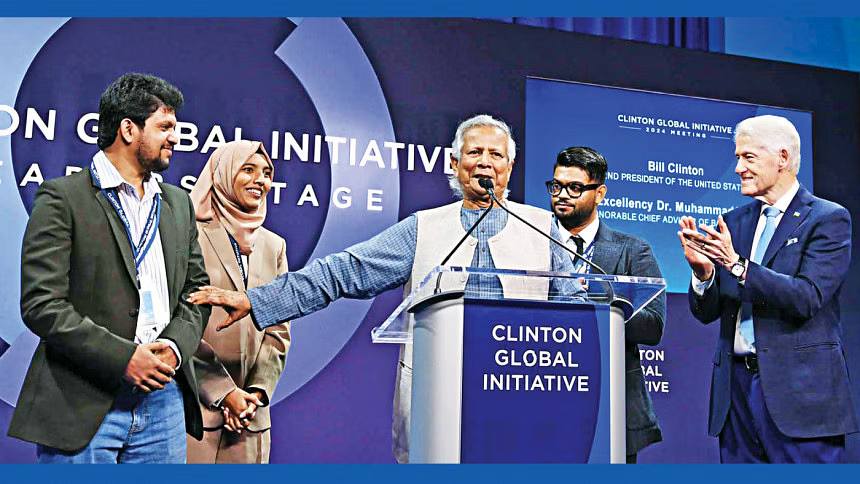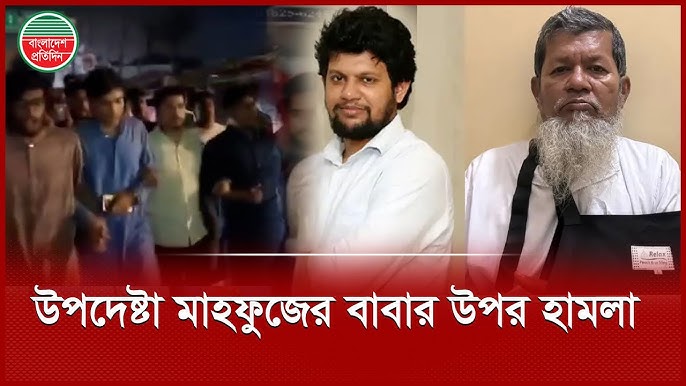US puppet Muhammad Yunus had described the July movement against the Awami League government as “meticulously designed” last September, saying it was not spontaneous.
That day, he introduced Mahfuj Alam, a former Shibir activist and follower of Ahle Hadith, as the mastermind of this conspiracy.
Yunus also said his recruiters—the students—had pushed the reset button to rewrite the history, implying that the narratives of the Liberation War and the contribution of Bangabandhu would change.
After that, many people, starting from coordinators Hasib Al Islam and Arif Sohel, said that they killed the police and set fire to various places, including the Metrorail, Setu Bhaban and BTV Headquarters. Moreover, BNP and Hefazat leaders said that they killed the police in Sirajganj.
Later, the interim government declared impunity for the killings, looting, and arson attacks committed by the protesters.
88 expat Bangladeshis condemn persecution of journalists
Sheikh Hasina: Jamaat-backed tribunal will not deliver justice
AL is blamed for mass killings, but Yunus Gang admitted it already
Many Shibir leaders have publicly said how they planned the movement, prepared demands, provided logistics, used leaders and activists from all over the country, and gathered activists at 10 points in Dhaka.
And today, Mahfuj could no longer hide the truth.
Within 11 months of seizing power, Adviser Mahfuj Alam admitted that they had conspired to overthrow the government. He brought students to the streets and committed murder and anarchy in a militant style, hiding their identities.

He has compared the conspiracy and terrorism of 2024 with the mass uprising of 1969 and the non-cooperation movement of 1971, which were aimed at independence from Pakistan.
In addition, in 1971, Biharis formed the Mujahid Bahini and played an important role in the genocide of Bangalis as part of the Pakistani army. Mahfuj has tried to distort that history and show it as a Bengali-Bihari riot, which is a poor attempt to establish the narrative of Henry Kissinger, Yahya Khan and Ghulam Azam.
Redefining mob
On Thursday night, Mahfuj said that the revolutionary students and people of July are not a mob. To prevent mob violence, the abolition of the fascist system, the rule of law, and effective and accountable democracy are needed.
Yunus regime dismisses executive magistrate Tapashee Tabassum for criticism
BNP’s mob attacks reach peak after Yunus-Tarique meeting
In a post on his verified Facebook ID, Mahfuj said the first “mob” violence in Bangladesh was against the Bihari community. Then the mob was against students and young freedom fighters who were against Mujibism.
He added that mobs have been against religious minorities for the last 53 years, directly fueled by the established political parties of Bangladesh. If we stretch the definition of “mob,” the so-called Jantar Adalat, Jantar Mancha of 1996, the October 28 protest by BNP in 2023, and the Shahbagh uprising—all are mob justice or mob violence.
However, Mahfuj on February 10 called for an end to mob violence. In a post on his verified Facebook profile, he said: “If you are in favour of the uprising, stop mob violence, and if you don’t stop it, you will be treated as devils.”
Mahfuj said the interim government will deal with mob violence with a strong hand from now on. “There will be no concessions if attempts are made to prove the state ineffective and failed,” he said.
Patiya police chief transferred after threat of bloodshed by Yunus’ mob gang
Activists showcase Bangladesh human rights violations in Geneva
Extrajudicial killings: GCDG lists 47 deaths since September 2024
Mahfuj later deleted this post from his profile.
His new stance on the mob came after the chief adviser’s press secretary, Shafiqul Alam, recently said that the mobs should be identified as “pressure groups.”

He argued that the newly vocal media cohort is comprised of those who felt victimised during the previous government’s tenure. “This is not a mob; this is a pressure group. It is occurring as a response to the failures and injustices in journalism over the past 15 and a half years. Those who were denied basic civil liberties during the Awami League regime are now voicing their grievances through this group.”
Who is Mahfuj?
In September 2024, Bangladeshi newspapers published a claim by the Jamaat-controlled interim government’s information ministry adviser, Mahfuj Alam, who initially advised chief adviser Yunus on politics and diplomacy.
The rebuttal came after some Indian media claimed that Mahfuj was a member of the banned militant group Hizb ut-Tahrir and Jamaat’s student wing, Islami Chhatra Shibir.
A key leader of the Students Against Discrimination platform’s liaison committee, which shaped the interim government, Mahfuj said on September 14 that he was never involved with the two radical Islamist groups.
However, since February, the former and current Shibir leaders, especially Khomenee Ehsan and Mohammad Ishrak, have exposed Mahfuj.
He drew attention after removing a portrait of the father of the nation, Bangabandhu Sheikh Mujibur Rahman, from Bangabhaban soon after taking oath as an adviser under the Constitution and by sharing a map of Bangladesh with parts of India as her territory, implying the jihadists’ long-term plan of Gazwatul Hind.
However, he softened his tone afterwards and is now talking about democracy instead of an Islamic Republic.
On March 6, a day before the Hizb ut-Tahrir’s March for Caliphate, Mahfuj chose not to make any comment when netizens asked him about the event by a banned militant group.

Mahfuj sounded irritated when asked about HuT. He pointed his finger at the home adviser while recounting his bitter experience of being bullied and threatened after speaking out against mob violence by radical Islamists, who are active across the country.
Many Shibir leaders have criticised Mahfuj for denying the facts that he was a Sathi of Shibir, he used to stay in a Shibir-run mess house, and he is married to the niece of a former Shibir president.
Mahfuj’s father, Azizur Rahman Bachchu Molla, is a BNP leader in Lakshmipur, and his father-in-law, Prof Dr Musleh Uddin, is the chief of an Ahle Hadith faction in Chittagong.
Mahfuj was a student of Tamirul Millat, a Jamaat-operated madrasa, before being admitted to Dhaka University. According to his aides, Mahfuj was staying on campus after completing his studies only to form a political force against the Awami League.
Apart from his camouflaged involvement with Shibir, Mahfuj was also associated with the leftists linked to Chhatra Federation, Chhatra Union, Rastro Songskar Andolan and Jatiya Insaf Kayem Committee of poet Farhad Mazhar.
Farhad Mazhar is unpopular for his live-in relationship with Farida Akhter, an adviser to the interim government, and Archana Rani Mistry, a former worker of his organisation who had to abort their child twice. In 2017, he staged an abduction drama after Archana sought money for an abortion.
Historians say Farhad Mazhar fled to the US after his involvement in a murder came to light when he was an active member of the Purbo Banglar Sorbohara Party, founded by Siraj Sikder.
Introduced globally as the brain behind the meticulously designed “coup”, dubbed as a student-led uprising, in July-August by Prof Muhammad Yunus, Mahfuj was first made special assistant to the chief adviser. At that time, he used to deal with the government’s political issues.
First part of the July uprising was meticulously designed
Mahfuj Alam clarified his position on the July conspiracy by asking a question on his Facebook on Friday: “If the mass uprising of 2024 was meticulously designed, where is the problem?”
He said: “There are two parts of the July mass uprising. From June 5 to July 18. In this part, the context and leadership of the uprising were created. And from July 19 to August 5, the uprising was successful with the participation and sacrifice of students and the public at all levels. The first part of the uprising was definitely meticulously designed.”

He wrote that in the first phase, there was a specific plan and statement by the leadership, without which the rebellion-resistance-self-sacrifice of the second phase could not have been successful.
Mahfuj said that the Agartala conspiracy case, the mass uprising of ’69, the non-cooperation movement of March ’71 and the Bengali-Bihari riots were all the result of a specific plan. None of those who led those incidents suffered from a sense of sin. Rather, the nation is proud of them.
“If Sirajul Alam Khan, Tajuddin Ahmed, Siraj Sikder, Maulana Bhashani or Sheikh Mujibur Rahman were not ashamed of being part of the meticulous design to defeat Pakistan, then why wouldn’t the current generation be proud if the mass uprising of ’24 was planned?”
He further claimed that before the one-point declaration of August 3, there was no involvement of any foreign power or military force in this uprising.
He said that the path to Bangladesh’s independence was paved through the Agartala conspiracy by meeting with India. “In that case, if the Hasina government could be overthrown by a people’s uprising without the support of any foreign power, why should leaders be criticized?”
He added that on the night of August 2, the uprising was at risk of taking a military turn, but that danger was also averted due to the leadership’s determination.